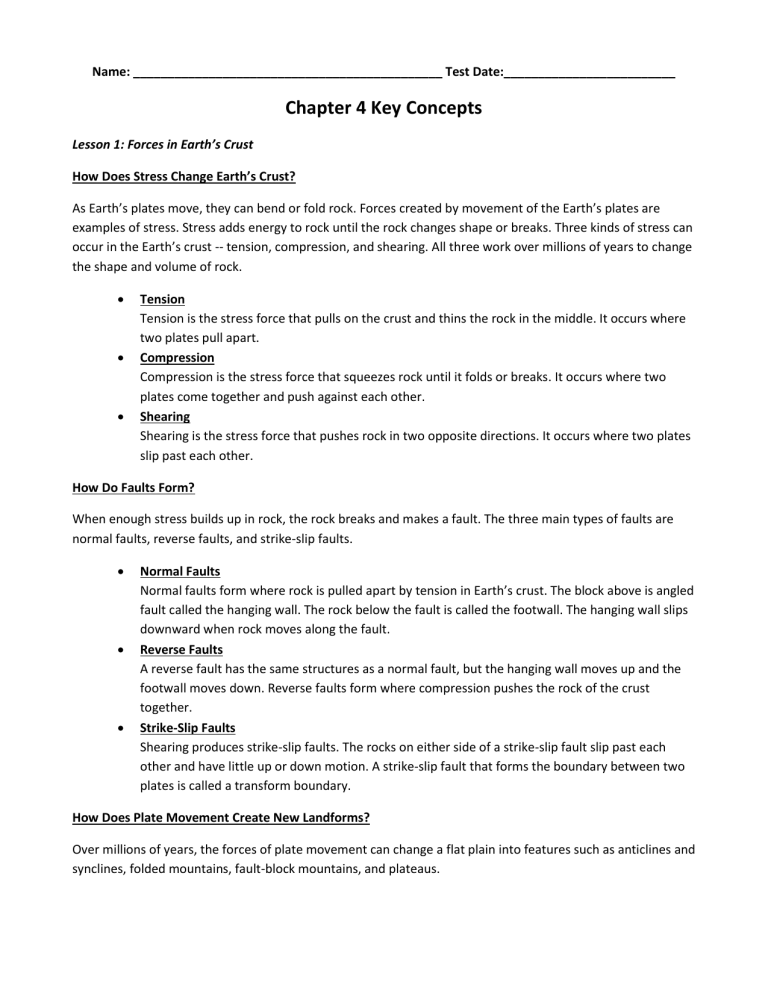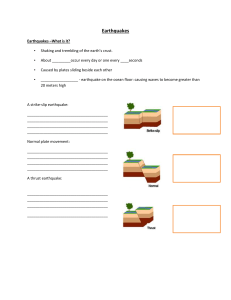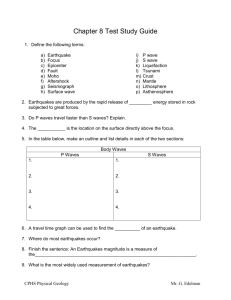Chapter 4 Key Concepts

Name: _____________________________________________ Test Date:_________________________
Chapter 4 Key Concepts
Lesson 1: Forces in Earth’s Crust
How Does Stress Change Earth’s Crust?
As Earth’s plates move, they can bend or fold rock. Forces created by movement of the Earth’s plates are examples of stress. Stress adds energy to rock until the rock changes shape or breaks. Three kinds of stress can occur in the Earth’s crust -- tension, compression, and shearing. All three work over millions of years to change the shape and volume of rock.
Tension
Tension is the stress force that pulls on the crust and thins the rock in the middle. It occurs where two plates pull apart.
Compression
Compression is the stress force that squeezes rock until it folds or breaks. It occurs where two plates come together and push against each other.
Shearing
Shearing is the stress force that pushes rock in two opposite directions. It occurs where two plates slip past each other.
How Do Faults Form?
When enough stress builds up in rock, the rock breaks and makes a fault. The three main types of faults are normal faults, reverse faults, and strike-slip faults.
Normal Faults
Normal faults form where rock is pulled apart by tension in Earth’s crust. The block above is angled fault called the hanging wall. The rock below the fault is called the footwall. The hanging wall slips downward when rock moves along the fault.
Reverse Faults
A reverse fault has the same structures as a normal fault, but the hanging wall moves up and the footwall moves down. Reverse faults form where compression pushes the rock of the crust together.
Strike-Slip Faults
Shearing produces strike-slip faults. The rocks on either side of a strike-slip fault slip past each other and have little up or down motion. A strike-slip fault that forms the boundary between two plates is called a transform boundary.
How Does Plate Movement Create New Landforms?
Over millions of years, the forces of plate movement can change a flat plain into features such as anticlines and synclines, folded mountains, fault-block mountains, and plateaus.
Folding Earth’s Crust
Folds are bends in rock that form when Earth’s crust is compressed and gets shorter and thicker. A fold in rock that bends upward into an arch is an anticline. A fold that bends downward in a V shape is a syncline.
Stretching Earth’s Crust
Tension forces create normal faults where two plates move away from each other. A fault-block mountain forms when the hanging walls of two normal faults drop down on either side of the
footwall.
Uplifting Earth’s Crust
Forces can also raise plateaus. A plateau is a large area of flat land that was lifted up high above sea level.
Lesson 2: Earthquakes and Seismic Waves
What Are Seismic Waves?
Plate movement increases the stress along a fault until the rock slips or breaks and an earthquakde begins. An earthquake is the shaking and trembling that happens when rock under Earth’s surface moves. The focus is the place under Earth’s surface where rock starts to move. The point on the surface directly above the focus is called the epicenter.
Some of the energy released during an earthquake travels through Earth in the form of seismic waves. Seismic waves travel out in every direction from the focus.
There are three main types of seismic waves: P waves , S waves, and surface waves.
P waves move the ground like you would pull and stretch a slinky.
S waves move the ground from side to side or up and down like you would wiggle or shake a jump rope with a friend.
When P and S waves reach the surface, some of them become surface waves. Surface waves can make the ground pitch and roll like ocean waves.
How Are Earthquakes Measured?
Geologists monitor earthquakes by measuring the seismic waves they produce.
The Modified Mercalli Scale
The Modified Mercalli scale rates the amount of shaking from an earthquake. The shaking is rated by what people observe and feel, without the use of any instruments.
The Richter Scale
An earthquake’s magnitude is a number geologists give to an earthquake based on its size.
Magnitude scales, like the Richter scale, rate earthquakes based on the size of the seismic waves recorded by a seismograph.
The Moment Magnitude Scale
The moment magnitude scale rates the total energy an earthquake releases. Geologists use data from seismographs and other sources to give an earthquake a magnitude.
Comparing Magnitudes
Each one-point increase in moment magnitude equals the release of about 32 times more energy.
Earthquakes with a magnitude below 5 are small and cause little damage, while those with a magnitude above 6 can cause great damage.
How is an Epicenter Located?
Geologists use seismic waves to locate an earthquake’s epicenter. The difference between arrival times of P and S waves at a seismograph station can be used to tell the distance of an earthquake’s epicenter. The farther away an earthquake is, the greater the difference of arrival times between the two waves. Geologists can then map the distance of the earthquake from at least three seismograph stations to focus in on the epicenter.
Lesson 3: Monitoring Earthquakes
How do Seismographs Work?
Many seismographs are complex electronic devices. However a simple seismograph can record earthquakes, too. A heavy weight with a pen hangs from a frame over a turning drum. Seismic waves cause a simple seismograph’s drum to vibrate, which in turn causes the pen to record the drum’s vibrations.
Measuring Seismic Waves
As the seismic waves arrive at a measuring station, the seismograph vibrates with the ground. The hanging weight resists the motion and tends to stay at rest. The pen records the vibrations as the paper moves under it.
Reading a Seismogram
A seismogram is the record of an earthquake’s seismic waves, produced by a seismograph. The height of the lines drawn by the seismograph tell geologists about the earthquake. If the lines are taller, the earthquake is more severe or is closer to the seismograph.
What Patterns do Seismographic Data Reveal?
Using past seismographic data, geologists have created maps of where earthquakes occur around the world.
The maps show that earthquakes often occur along plate boundaries.
Earthquake Risk in North America
Earthquake risk largely depends on how close a given location is to a plate boundary. In the United
States, two plates meet along the Pacific coast. An earthquake risk map shows that most serious earthquakes occur in this area.
Earthquake Risk Around the World
Many of the world’s earthquakes occur in an area of geologic activity called the Ring of Fire. In this area, plate boundaries form a ring around the Pacific Ocean. Earthquakes are also common in area where two plates pull apart, like the Arabian peninsula and the northeast coast of Africa.








